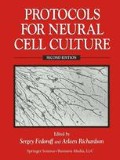Abstract
Cell enumeration using the hemocytometer is applicable when determining the number of cells in a suspension and when the number of samples to be analyzed is relatively small. Hemocytometry is also useful for determining the proportion of singly dispersed cells in a suspension and an estimation of the frequency of viable cells.
Access this chapter
Tax calculation will be finalised at checkout
Purchases are for personal use only
Preview
Unable to display preview. Download preview PDF.
Further Reading
Bainbridge, D. R. and Macey, M. M. (1983), Hoechst 33258: a fluorescent nuclear counterstain suitable for double-labelling immunofluorescence. J. Immunol. Methods 62, 193–195.
Baserga, R. (1989), Measuring parameters of growth, in Cell Growth and Division, Baserga, R., ed., IRL, New York.
Borenfreund, E. and Puerner, J. A. (1985a), A simple quantitative procedure using monolayer cultures for cytotoxicity assays (HTD/NR-90). J. Tissue Culture Methods 9, 7–9.
Borenfreund, E., Puerner, J. A. (1985), Toxicity determined in vitro by morphological alterations and neutral red absorption. Toxicol. Lett. 24, 119–124.
Borenfreund, E., Babich, H., Martin-Alguacil, N. (1988), Comparisons of two in vitro cytotoxicity assays—the neutral red (NR) and tetrazolium MTT tests. Toxicol. In Vitro 2, 1–6.
Branch, D. R. and Guilbert, L. J. (1986), Practical in vitro assay systems for the measurement of hematopoietic growth factors. J. Tissue Culture Methods 10, 101–108.
Clark, G. (1981), Staining Procedures 4th ed., Williams and Wilkins, Baltimore, MD.
Demalsy, P. and Callebaut, M. (1967), Plain water as a rinsing agent preferable to sulfurous acid after the Feulgen nuclear reaction. Stain Technol. 42, 133–136.
De Tomasi, J. A. (1936), Improving the technic of the Feulgen stain. Stain Technol. 11, 137–144.
Dulbecco, R. and Vogt, M. (1954), Plaque formation and isolation of pure cell lines with poliomyelitis viruses. J. Exp. Med. 99, 167–182.
Elias, J. M., Conkling, K., and Makar, M (1972), Cold feulgen hydrolysis: its effect on displacement of tritiated thymidine. Acta Histochem. Cytochem. 5, 125–131.
Hamilton, L. H. (1956), Errors in blood cell counting. 1. Technical errors. 2. Statistical errors. Can. J. Med. Tech. 18, 8–14.
Hanks, J. H. and Wallace, R. E. (1958), Determination of cell viability. Proc. Soc. Exper. Biol. Med. 98, 188–192.
Harris, M. (1959), Growth measurements on monolayer cultures with an electronic cell counter. Can. Res. 19, 1020–1024.
Hilwig, I. and Gropp, A. (1972), Staining of constitutive heterochromatin in mammalian chromosomes with a new fluorochrome. Exp. Cell Res. 75, 122–126.
Jones, K. H. and Senft, J. A. (1985), An improved method to determine cell viability by simultaneous staining with fluorescein diacetate propidium iodide. J. Hist. Cytol. 33, 77–79.
Kaltenbach, J. P., Kaltenbach, M. H., and Lyons, W. B. (1958), Nigrosin as a dye for differentiating live and dead ascites cells. Exp. Cell Res. 15, 112–117.
Kjellstrand, P. T. T. (1977), Temperature and acid concentration in the search for optimum Feulgen hydrolysis conditions. J. Histochem. Cytochem. 25, 129–134.
Kolber, M. A., Quinones, R. R., Gress, R. E., and Henkart, P. A. (1988), Measurement of cytotoxicity by target release of the fluorescent dye bis-carboxymethyl-carbosyfluorescein (BCECF). J. Immunol. Meth. 108, 225–264.
Latt, S. A. and Stetten, G. (1976), Spectral studies on 33258 Hoechst and related bisbenzimidazole dyes useful for fluorescent detection of deoxyribonucleic acid synthesis. J. Histochem. Cytochem. 24, 24–33.
McLimans, W. F., Davis, E. V., Glover, F. L., and Rake, G. W. (1957), The submerged culture of mammalian cells: the spinner culture. J. Immunol. 79, 428–433.
Moore, P. L., MacCoubrey, I. C., and Haugland, R. P. (1990), A rapid, pH insensitive, two color fluorescence viability (cytotoxicity) assay. J. Cell Biol. 111, 304 (abstract).
Mullbacher, A., Parish, C. R., and Mundy, J. P. (1984), An improved colorimetric assay for T cell cytotoxicity in vitro. J. Immun. Methods 68, 205–215.
Parish, C. R., Mullbacher, A. (1983), Automated colorimetric assay for T cell cytotoxicity. J. Immun. Methods 58, 225–237.
Pevzner, L. Z. (1979), Functional Biochemistry of the Neuroglia. Consultants Bureau, New York.
Phillips, H. J. and Andrews, R. V. (1959), Some protective solutions for tissue-cultured cells. Exper. Cell Res. 16, 678–682.
Phillips, H. J. and Terryberry, J. E. (1957), Counting actively metabolizing tissue cultured cells. Exper. Cell Res. 13, 341–347.
Roehm, N. W., Rodgers, G. H., Hatfield, S. M., and Glasebrook, A. L. (1991), An improved colorimetric assay for cell proliferation and viability utilizing the tetrazolium salt XTT. J. Immunol. Methods 142, 257–265.
Sanford, K. K., Earle, W. R., Evans, V. J., Walts, H. K., and Shannon, J. E. (1951), The measurement of proliferation in tissue culture by enumeration of cell nuclei. J. Nat. Canc. Inst. 11, 733–795.
Schrek, R. (1944), Studies in vitro on the physiology of normal and of cancerous cells. II. The survival and the glycolysis of cells under anaerobic conditions. Arch. Path. 37, 319–327.
Thornthwaite, J. T. and Leif, R. C. (1978), A permanent cell viability assay using Alcian blue. Stain Technology 53, 199–204.
Waymouth, C. (1956), A rapid quantitative hematocrit method for measuring increase in cell population of strain L (Earle) cells cultivated in serum-free nutrient solutions. J. Nat. Canc. Inst. 17, 305–313.
Yip, D. K. and Auersperg, N. (1972), The dye exclusion test for cell viability: persistence of differential staining following fixation. In Vitro 7, 323–329.
Editor information
Editors and Affiliations
Rights and permissions
Copyright information
© 1997 Springer Science+Business Media New York
About this chapter
Cite this chapter
Richardson, A., Fedoroff, S. (1997). Quantification of Cells in Culture. In: Fedoroff, S., Richardson, A. (eds) Protocols for Neural Cell Culture. Humana Press, Totowa, NJ. https://doi.org/10.1007/978-1-4757-2586-5_16
Download citation
DOI: https://doi.org/10.1007/978-1-4757-2586-5_16
Publisher Name: Humana Press, Totowa, NJ
Print ISBN: 978-0-89603-454-9
Online ISBN: 978-1-4757-2586-5
eBook Packages: Springer Book Archive

